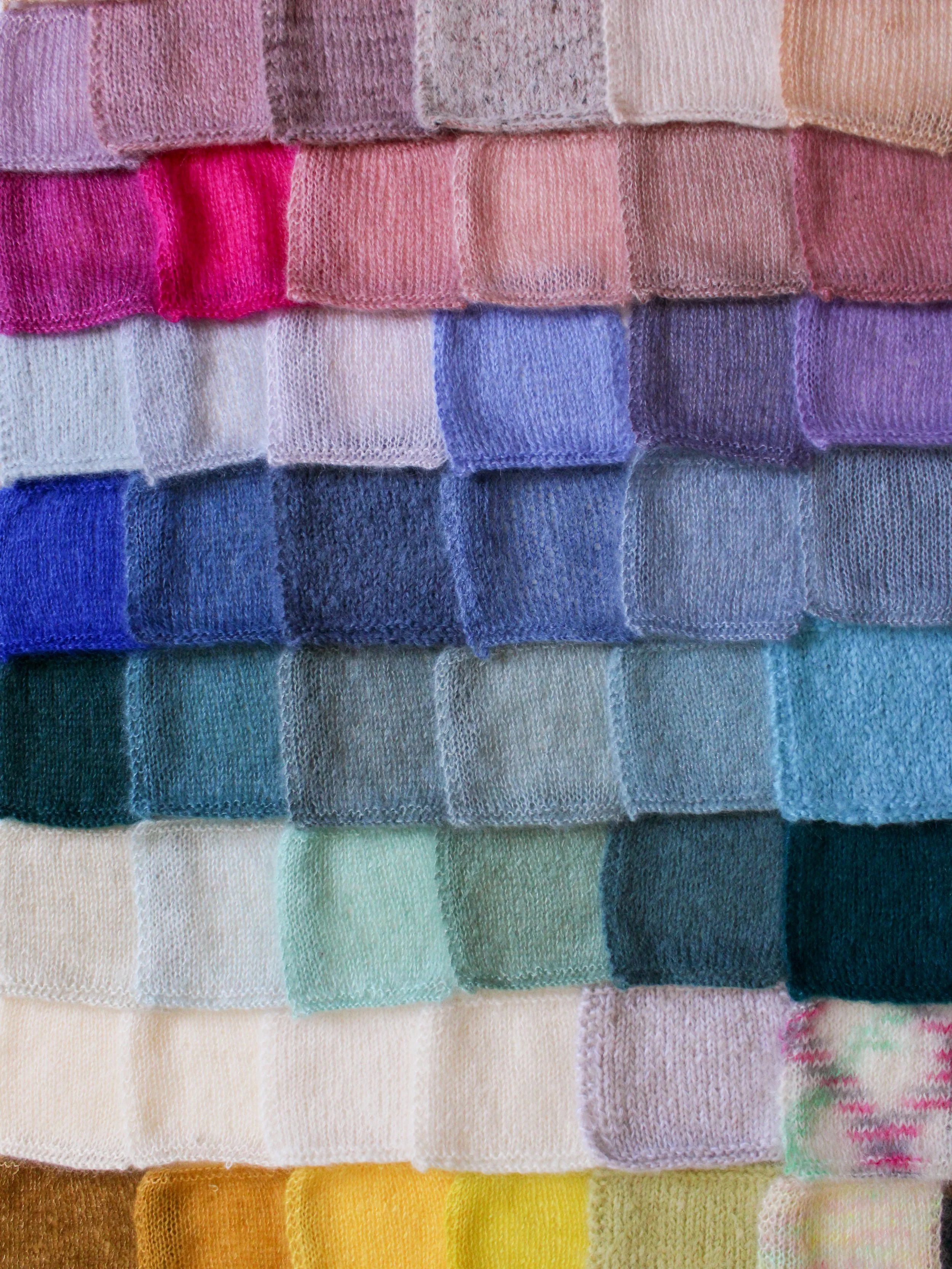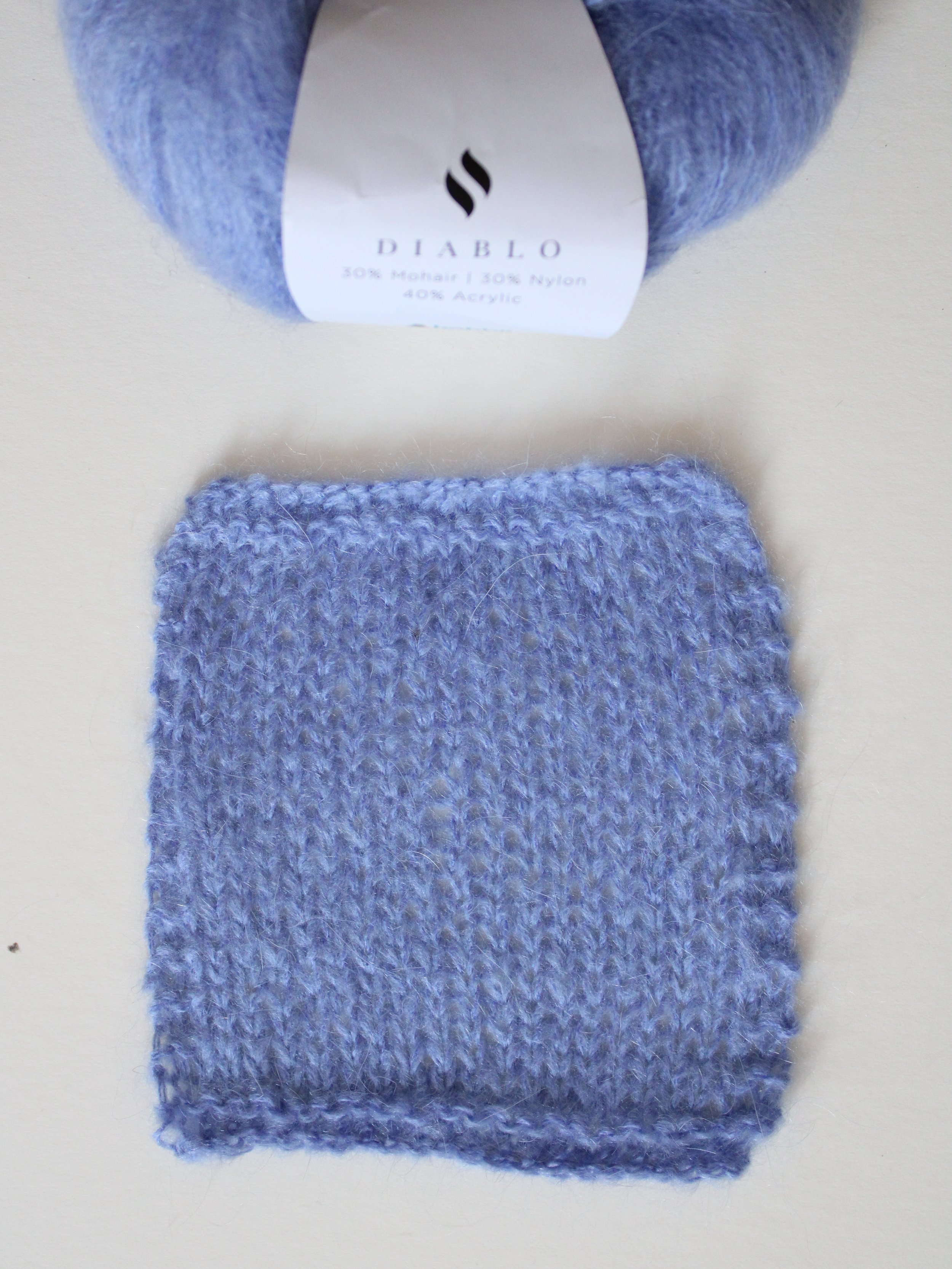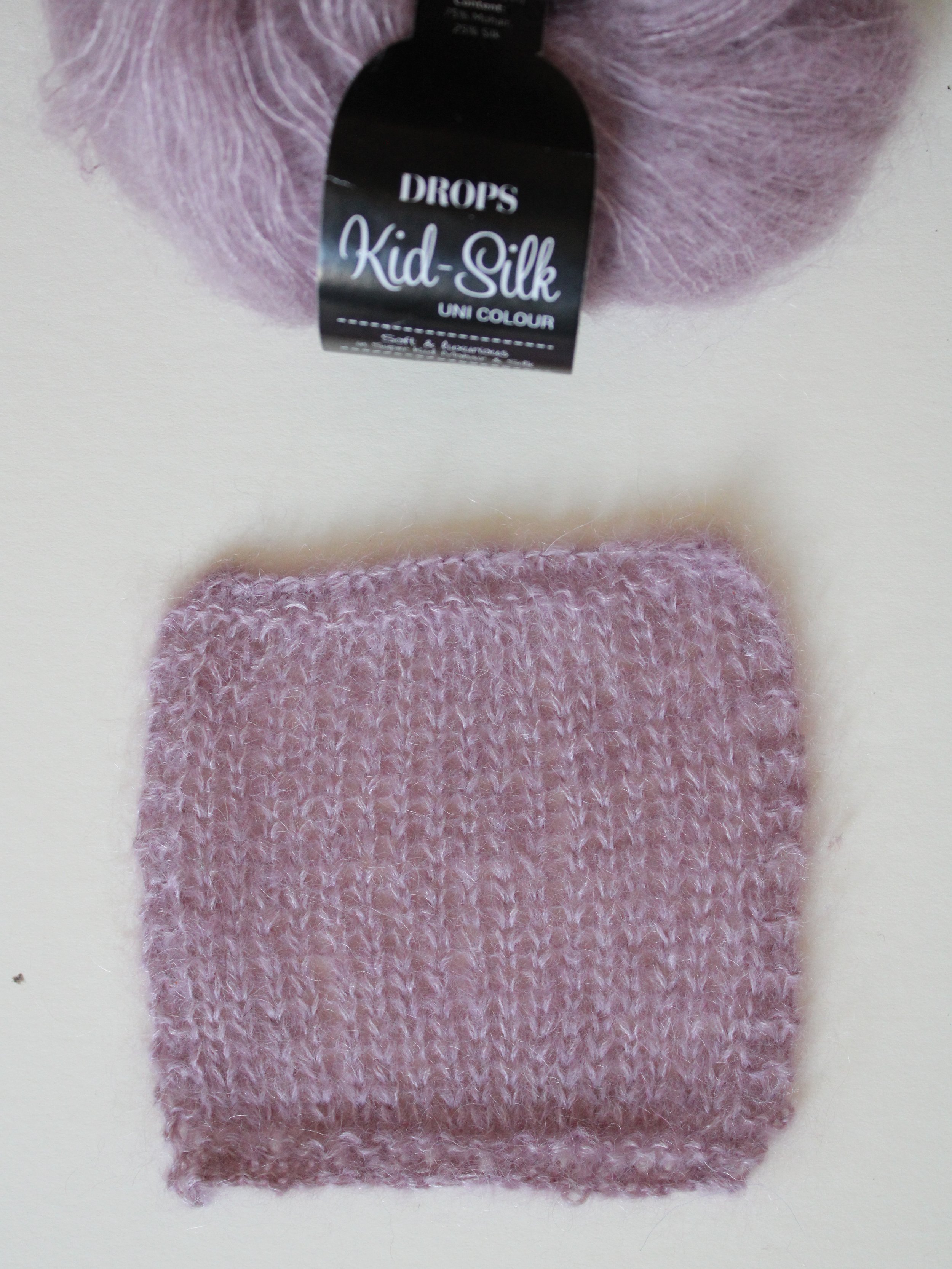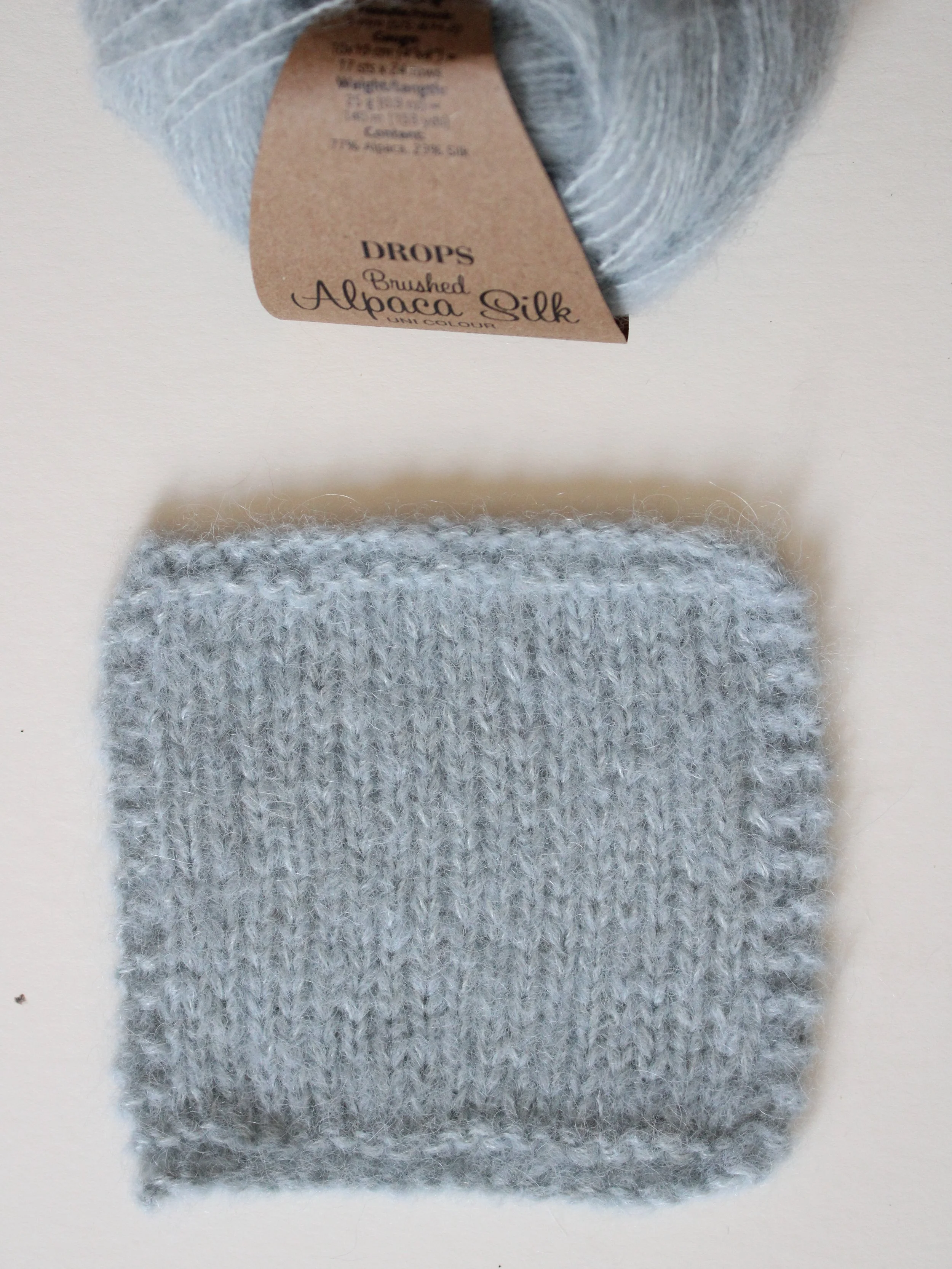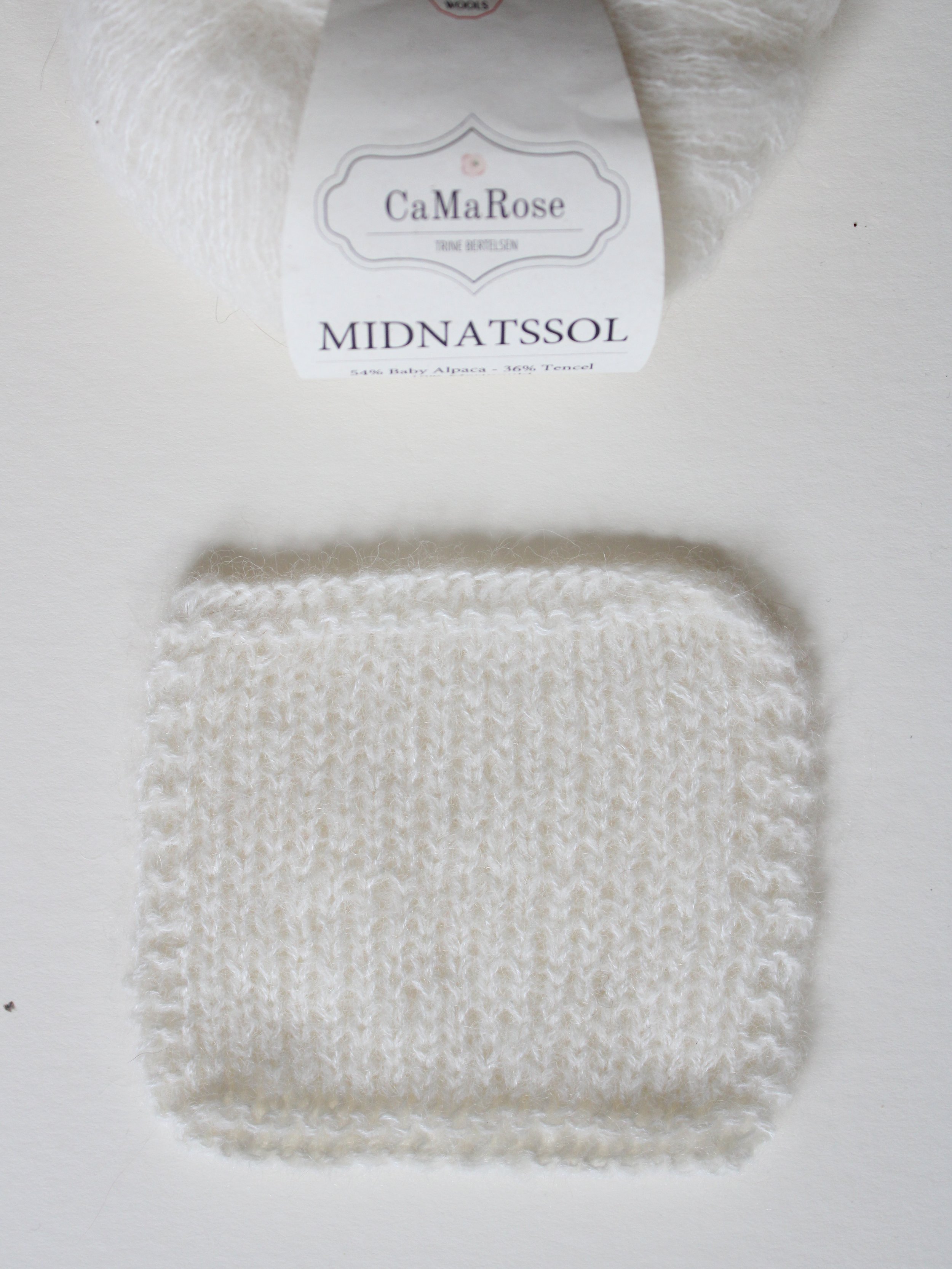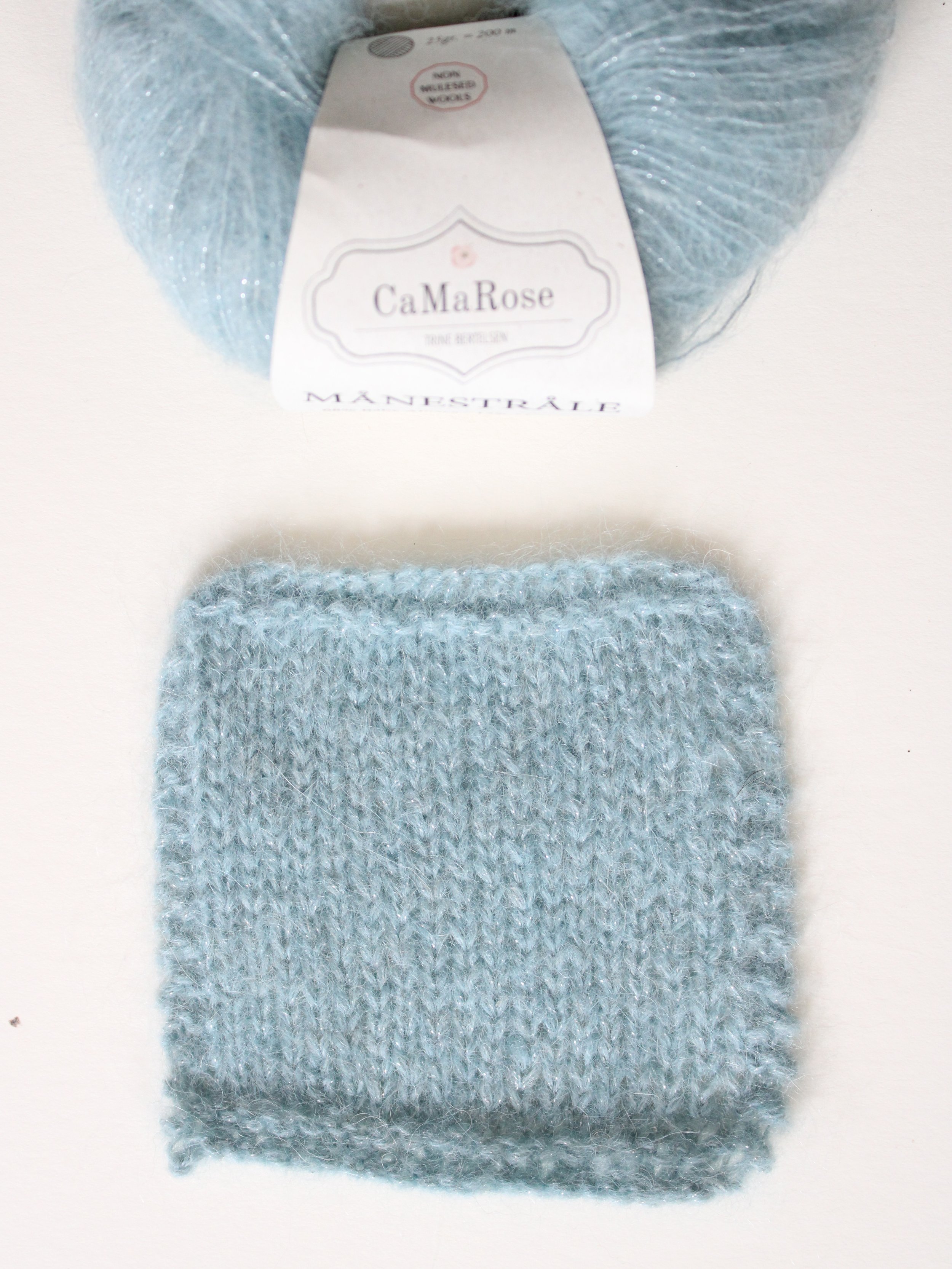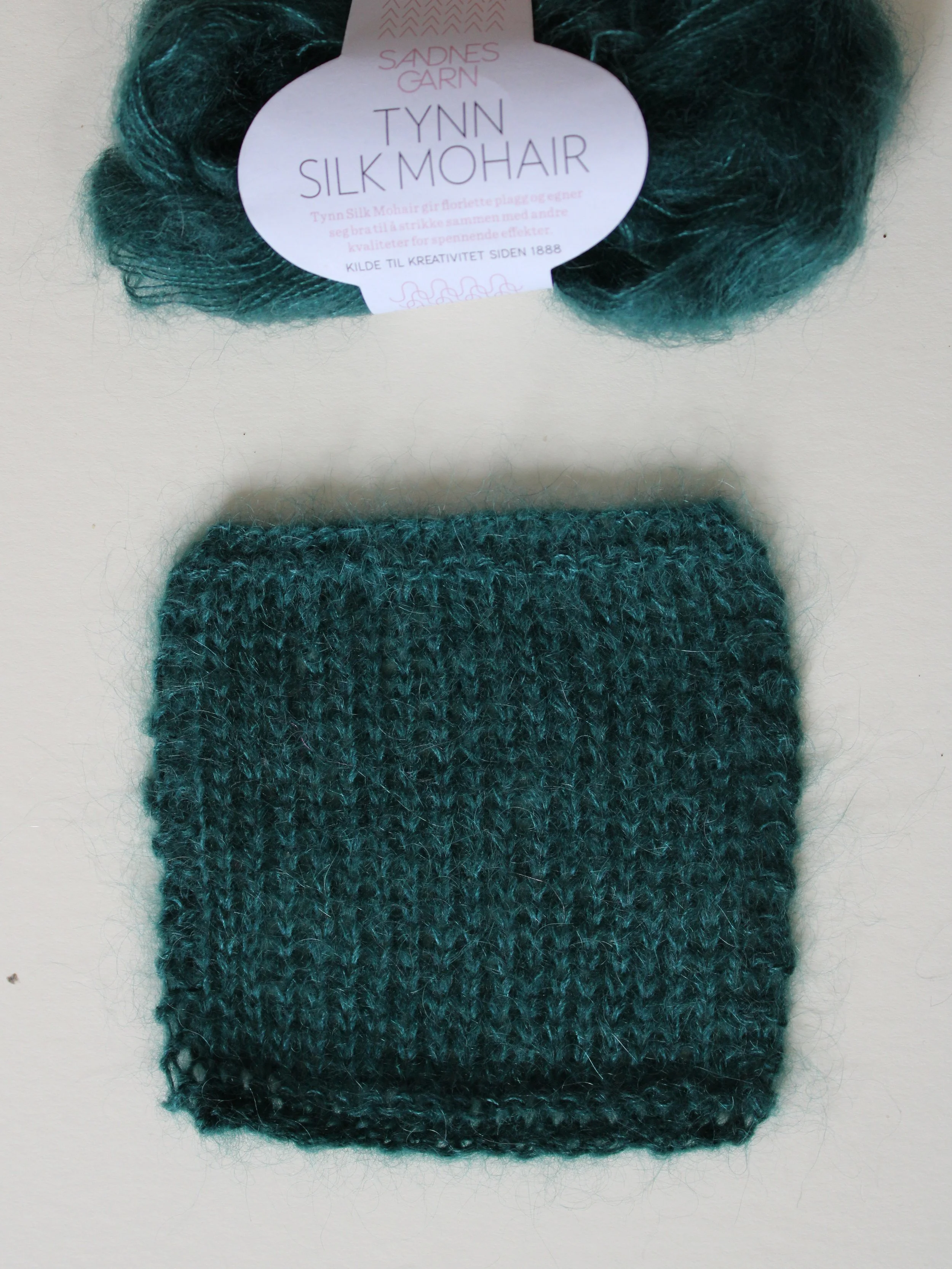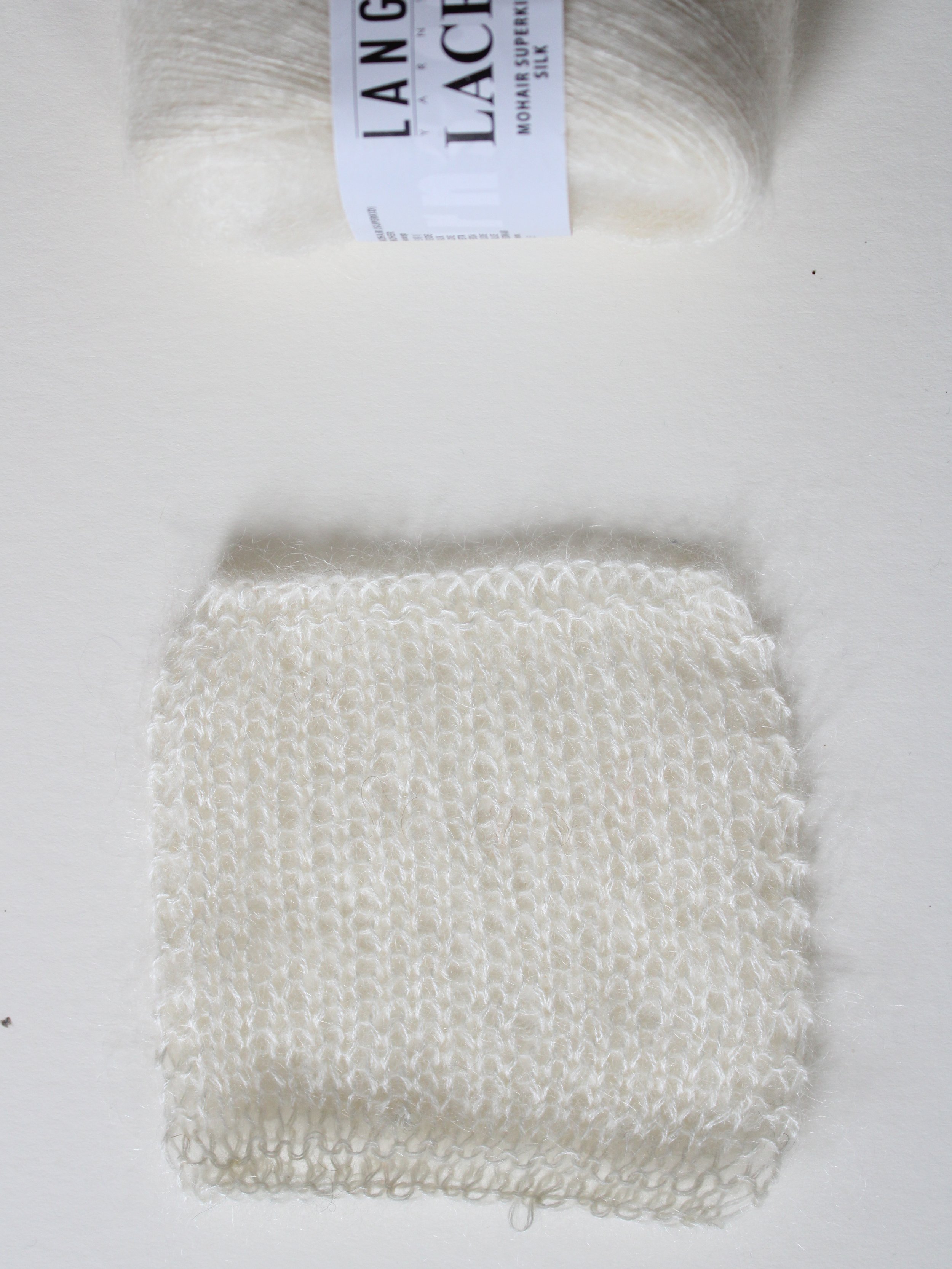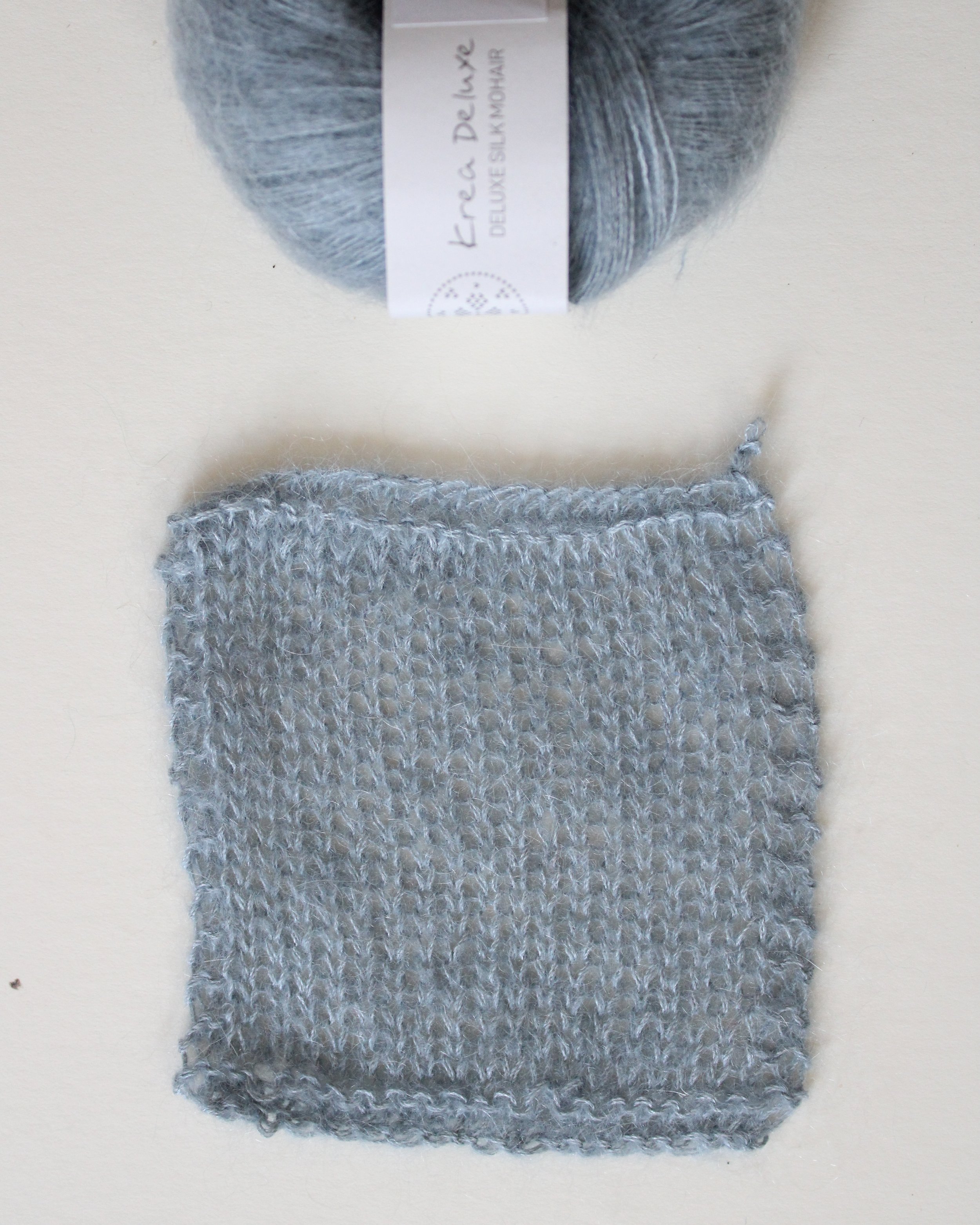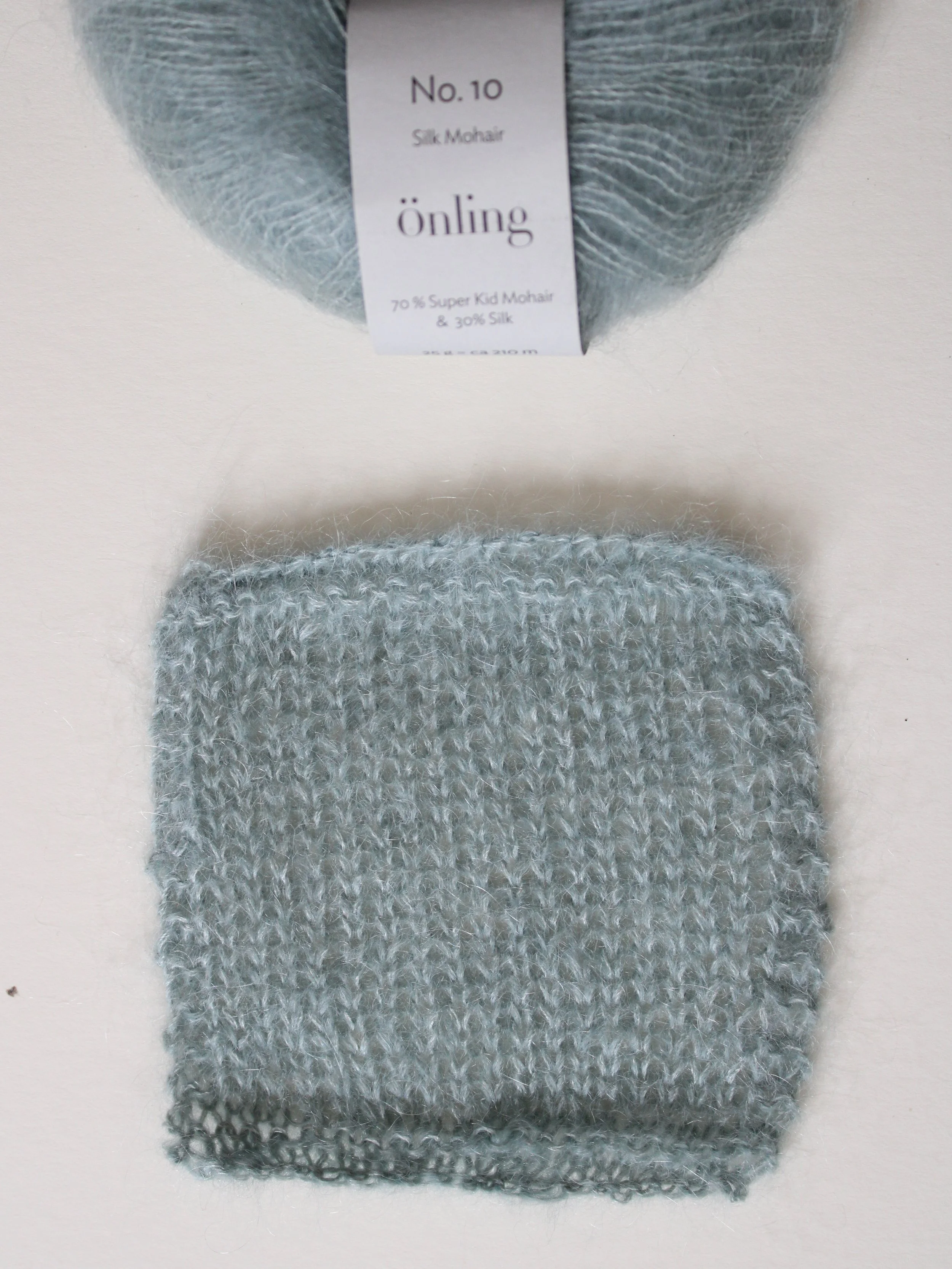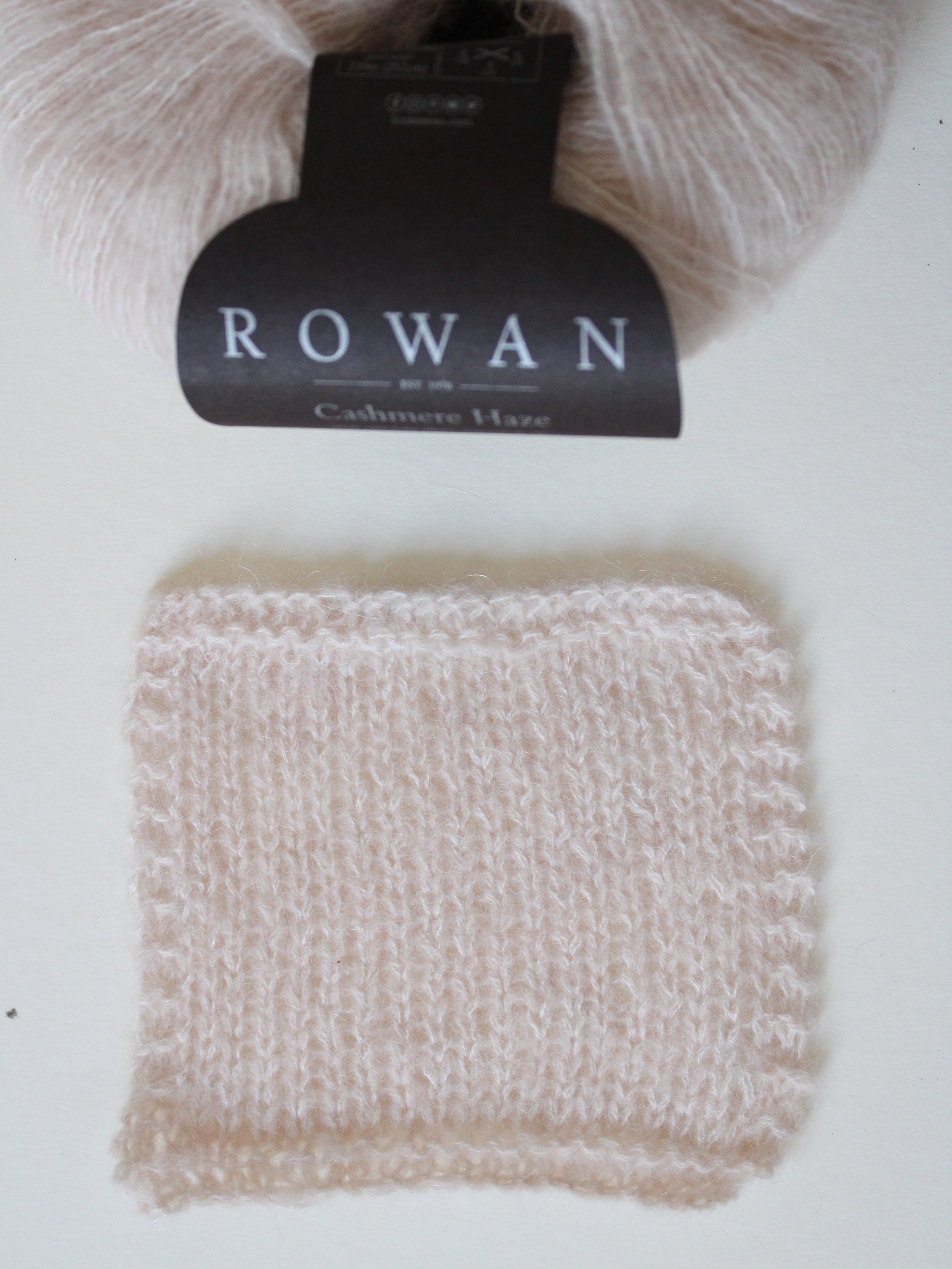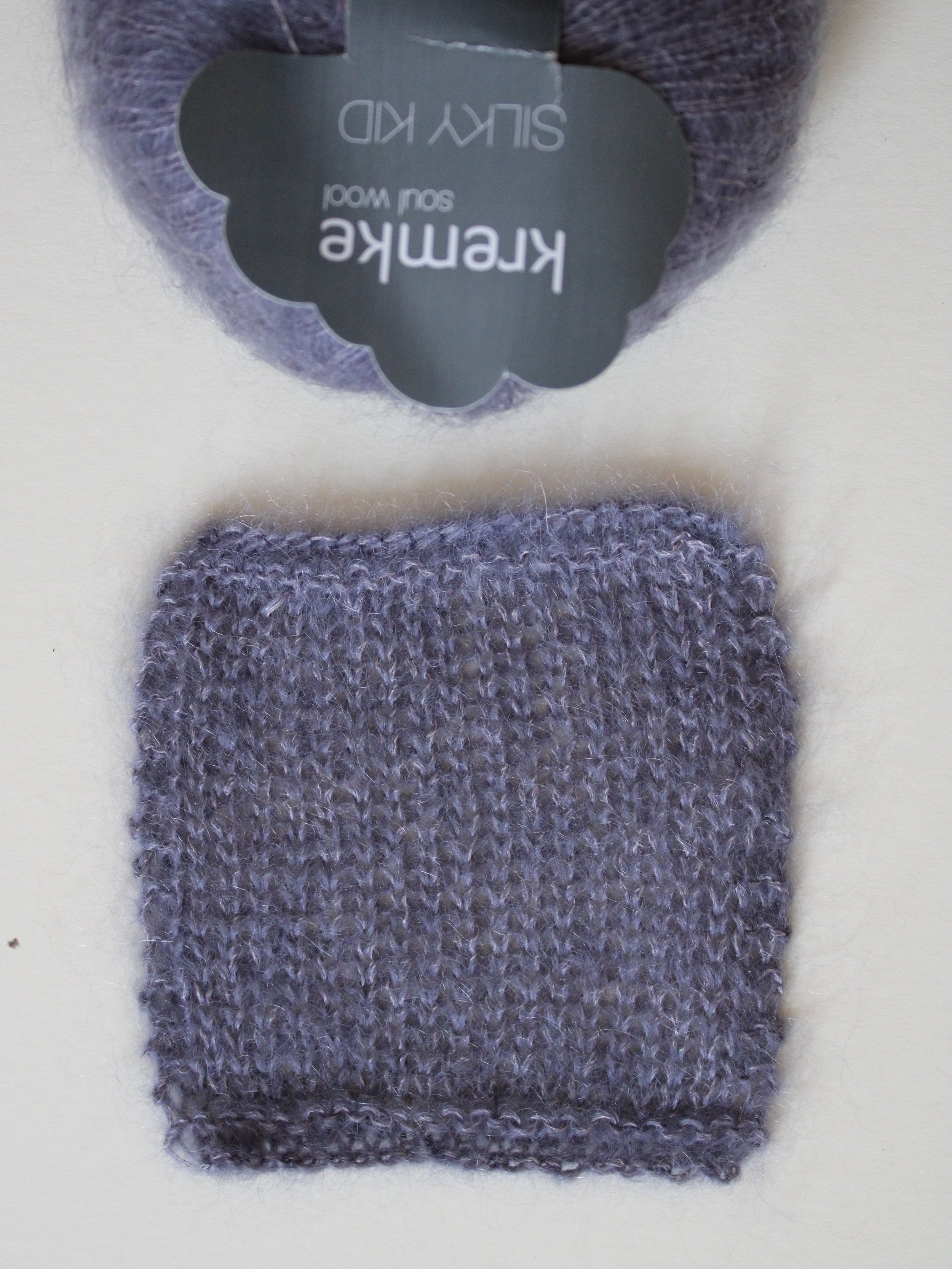I tried (almost) every mohair on the market so you don't have to (ad)
Hi, my name is Sophie and I am obsessed with mohair. Like, really obsessed with the stuff. It's my favourite type of yarn to try and review and, for some reason, I decided last year that it would be a good idea to try as many different mohair yarns available on the UK market as I could. About £600 (yes, really. Don't tell my mum!) and many, many swatches later, I'm finally ready to share some of my preliminary findings. I intend to publish a document with reviews of every single yarn I tried later in the year, but I'm hoping this will do for now. The blogpost accompanies a video I've also published on YouTube, which you can watch below or by clicking here.
So, without any further ado, let's get into it...
But first, some notes on my mohair research methodology...
Spoken like a true PhD student, I know... The aim of the game in this project has been consistency. I want to be able to evaluate the merits of each product and to see how different blends, thicknesses, and price points affect the knitting experience. I have not followed the respective yarn manufacturers’ instructions, but have instead swatched each yarn held double on the same 5mm needles. Each swatch contains the same number of stitches, which happens to be 18 stitches over 23 rows. In most cases, this works knits up to a circa 10 cm x 10 cm piece of fabric. Each swatch has a 2-row and 2-stitch garter stitch border and I have held each yarn double. I steam blocked each swatch with my iron, which I would not normally recommend, but, for the sake of not having to live around 60+ wet swatches, it was worth the shortcut!
To avoid any conflict of interest, I have purchased almost all of the yarns I write about here and show in the accompanying YouTube video. Where the yarns were gifted to me, I have indicated clearly. I have remained objective in my reviews.
There are certain things that I have not mentioned in my reviews, namely how scratchy each yarn feels. Personally, I do not find mohair to be scratchy at all. I am therefore unable to comment one way or the other on this. Unless I have been told something about a particular yarn multiple times or have used a yarn in a garment myself, I also have not commented on how each yarn wears. Again, it is beyond the scope of this project but I am happy to receive anecdotal feedback by email (the.knit.purl.girl2020@gmail.com).
Mohair yarns to avoid
Hobbii Diablo
£4.50 per skein, though the price can be lowered with bulk discounts / 225 m per skein / 100 m = £2
40% acrylic, 30% mohair, 30% polyamide
Available in around 60 shades, in addition to 20 Wild Print shades, 15 Print shades, and 10 Glitter shades
I really wanted to like this more than I do, but I just don’t like acrylic-based yarns. I’m sorry! I can see what Hobbii were going for with Diablo; it’s pretty budget-friendly, it’s available in lots of colours and finishes (there are printed and even glittery versions of Diablo!), and it yields nice thick stitches, meaning that you can probably use 2 strands held together in a pattern that calls for 3 strands, like my own Aosta Sweater Mohair Edition. It also very much feels like a synthetic-blend yarn. If I compare this with Hip Knit Hip Mohair, Adriafil Kid Mohair, or Scheepjes Mohair Rhythm, all of which are also synthetic-mohair blends, or even Hobbii’s Mohair Delight, which is a 50:50 mohair : acrylic blend, Diablo feels, frankly, cheap and plastic-y.
The fabric itself is broadly fine and the yarn is available in an excellent range of colours to suit all tastes. However, you can absolutely tell that it contains acrylic and nylon (though I think the acrylic is the main offender!), as the finish is quite matte and the stitch definition is only so-so. This plays out more in the skein, where the synthetic content really offends me. I really did not enjoy knitting this swatch. And I love knitting swatches! I have chronic dry skin on my hands so I am very aware of yarns that catch on dry skin, and Diablo was appropriately devilish.
It’s worth nothing that Diable is one of the cheaper mohair yarns out there. Similarly to Hobbii’s ‘regular’ Kid Silk mohair, you can save a whopping 40% on your purchase if you buy 10 skeins at once at the time of writing, brining the cost per 100 m down to £1.20 and the overall cost to £27. The flip-side of this is that it really does feel like a yarn that costs £1.20 per 100 m. Whilst I do believe that you generally get what you pay for, there is no reason why cheap yarn should have to be bad. If you are shopping for mohair on a budget, I would advise looking at Drops Kid Silk Mohair or Brushed Alpaca Silk over this any day of the week. Simply put, they are better yarns.
I would also mention that acrylic yarns are a sustainability nightmare. My friend Abbie (@abbieknits) has written about this at length and with much more expertise than I could ever hope to have, and I encourage you to read her blog to find out more about acrylic (link below). Of course, there is an argument to be made about the sustainability and ethics of any animal-fibre-based yarn, but considering this also contains mohair, I find Diablo to be particularly frustrating. I would prefer it if it were 100% synthetic because it would then be vegan-friendly and therefore more versatile.
I am really sorry to give this yarn a negative review. I always try to see the best in a product, and I know people who have used Diablo to great effect and who really like it; I'm just not one of them.
Hobbii Alpaca Blaze
£4.90 per skein, though the price can be lowered with bulk discounts / 225 m per skein / 100 m = £2.18
40% acrylic, 30% alpaca, 30% polyamide
Available in around 50 shades
Much like Hobbii Diablo, I am sorry to report that I did not like and do not see the point in this yarn. There, I said it! Essentially, this is the alpaca-based version of Diablo. I’d say it’s marginally softer than it’s mohair cousin, but I mean it when I say ‘marginally’. To look at, the finish of the two yarns is virtually identical. This makes quite a lot of sense to me, considering that 70% of the composition is almost identical, the only difference being the 30% mohair or alpaca content either way and the synthetic silk alternative.
And, unfortunately, many of my comments about Diablo also apply here. The fabric itself feels okay – I can tell it contains acrylic, it could be softer, and I personally would not choose to reach for it, but it’s broadly fine. It has a nice enough drape and the stitch definition is pretty good, with some nice texture from the longer strands of alpaca. The knitting experience, however, was quite unpleasant! It caught on every piece of dry skin on my hands and the strands stuck to themselves a lot, making the whole experience feel quite difficult.
What gets me, though, is that this yarn is more expensive than Diablo, which I cannot get my head around. As with all yarns from Hobbii, you can get discounts by buying multiple skeins at once, but I still think this yarn is dramatically overpriced. Indeed, I find this yarn and Diablo frustrating because I know that Hobbii are perfectly capable of making beautiful yarns with these fibres. Their Alpaca Silk is lovely! Their Alpaca Lace is lovely! Their Kid Silk is lovely! There’s no reason to make a yarn like Alpaca Blaze or Diablo, in my opinion, other than to capitalise on and exploit people who want the look of a mohair but who don’t want to spend a lot of money. It really rubs me the wrong way when there are other, much better and cheaper products on the market. Rant over! If you’re looking for a mohair alternative and are working on a strict budget, I would not recommend using this yarn.
Budget-friendly mohair yarns
Drops Kid-Silk
£3.80 per skein / 210 m per skein / 100 m = £1.81
75% mohair, 25% silk
Available in 37 shades
Drops’ mohair offering has the honour of being the cheapest mohair on the market per 100m. It was also the first mohair I ever tried and so it holds a special place in my heart and, for that matter, personal stash. There is a more extensive review of this yarn on my blog, should you wish to check it out, but we’ll keep to the format here and go over the basics.
Despite the low price point, I do think that Drop’s Kid-Silk Mohair is a good quality yarn and is a great entry point to the wonderful, fluffy world of mohair. It worked up very nicely held double on the 5mm needles, and struck a good balance between stitch definition and fluff. The silk in the yarn is visible and adds a little bit of glow to any given project. There is some shedding and it isn’t the softest mohair yarn I’ve tried, but it is far from being the worst offender on this list. Indeed, in a blind test, I think that this yarn can hold its own against much more expensive yarns. In my experience, it works up nicely on a range of needle sizes. I’ve used it held quadruple for lace on 5mm needles and on 7mms for a Petite Knit design, so I’d say it’s a versatile yarn that is a true workhorse in any stash.
For me, however, Drops Kid-Silk mohair is best suited for holding with other wools. If I’m making an entire sweater out of mohair, I’d be more inclined to reach for a slightly more expensive and ‘special’ mohair as these tend to have a bit more dimension and character than Drops Kid-Silk. All the same, I tend to reach for this yarn most often when I am working with another yarn like We Are Knitters The Petite Wool and want to add some fluff, sheen, and extra softness. It works a treat and doesn’t make the project too much more expensive than it would have been without the mohair.
My main concern with this yarn is exactly how Drops manage to sell it for so little money. I assume it largely comes down to economies of scale; Drops is a large company with, I imagine, a lot of buying power, but I do wonder how this affects the production line. I don’t want to make any unfounded accusations against Drops, but I would love to know how these savings are created in the production process. This being said, if you are working on a budget, I wholeheartedly recommend this yarn. You can’t go too far wrong with it and I would reach for this over an acrylic blend (looking at you, Hobbii Diablo!) any day.
Drops Brushed Alpaca
£2.60 per skein / 140 m per skein / 100 m = £1.86
77% alpaca, 23% silk
Available in 25 shades
If you’re not a fan of mohair and are working on a budget, this is the yarn for you. I really enjoyed working with Drops Brushed Alpaca Silk. As with most, if not all, alpaca-based yarns in this category, it is noticeably thicker than a ‘true’ mohair, but so long as you allow for a potential difference in gauge when following a mohair pattern, you will end up with a beautiful garment or accessory. The resulting fabric is dense, with a close, brushed finish (as the name would imply!), with glints of light coming through from the silk content of the yarn. It’s not particularly fuzzy with a minimal halo, which seems to be characteristic of this kind of suri alpaca-/brushed alpaca-silk blend. The finish is very pretty indeed. I would be interested to see this knitted in lace, as I think you would be able to see the stitches quite clearly with minimal interference from any fuzz. I could see myself making some cosy and light mittens with this yarn, but probably wouldn’t choose to use it for a sweater myself, though this speaks more to my own personal preference for mohair over alpaca than anything about the quality of the yarn itself.
This is the cheapest yarn per skein included in this survey, but it’s important to note that the skeins are significantly shorter than most mohair yarns, so you will need to do a bit of maths to work out how many skeins you will need if using this as a substitute for another yarn.
CaMaRose Midnatssol
c. £5.75(-£6) per skein / 200 m per skein / 100 m = c. £2.88 (based on £5.75 per skein, which is what I paid)
54% baby alpaca, 36% tencel, 10% merino wool
Available in 28 shades
In my humble opinion, this is the best mohair alternative available on the market. It’s a really nice and pretty budget-friendly blend of alpaca, Tencel, and merino wool that is a true lace-weight product that you would be able to use as an accurate substitute for most patterns designed for mohair yarns. It’s very soft with nice stitch definition, a matte and slightly fluffy finish, and a very pretty drape. The finish of Midnatssol has a lot in common with its cousin Månestråle, just without the sparkles, so if you know that you like that yarn, you’ll probably also get on well with Midnatssol. The inclusion of Tencel instead of silk is really interesting. It straddles the line between synthetic and natural, as it’s man-made (synthetic) from wool pulp (natural), so it’s an interesting fibre! In Midnatssol, it acts much like a silk, adding sheen and integrity to the yarn. It's also surprisingly affordable, making it a good option for those working on a budget.
CaMaRose Månestråle
c. £5 per skein / 200 m per skein / 100 m = £2.50 (again, I think the price may have increased slightly since I purchased my skein)
68% baby alpaca, 12% merino wool, 16% polyamide, 4% polyester
Available in 16 shades
Do you like fluff? Do you like sparkles? Do you like mohair alternatives that are basically the same weight as a ‘regular’ mohair? Yes to all three? Great. This is the yarn for you. Månestråle – or, in English, Moon Beam – is aptly named. This is an alpaca-based yarn with a gentle twinkle that comes from a strand of glittery thread within the blend. The most comparable product here is We Are Knitters The Bling Bling but, in truth, I prefer Månestråle, especially on 5mm needles. The stitches are fuller, fluffier, and the sparkle is a bit more subtle. If you’re looking for something eye-catching and a little bit unusual, this would be a great choice.
The blend of fibres in Månestråle is quite interesting. Like its cousin, CaMaRose Midnotsol, the main component of this yarn is baby alpaca with a touch of merino wool. This yields a soft and gently fluffy fabric with a matte finish and soft stitch definition. Unlike other alpaca-based mohair alternatives, both CaMaRose yarns are a closer to a true lace weight and could be used in much the same way as a mohair. Two strands together was just right on 5mm needles, but you might want to swatch to check your gauge for anything smaller, especially if you are using Månestråle or Midnotsol as a substitute for a very fine mohair, like the Krea Deluxe, Onion, or Lang yarns featured here. I think the differ Månestråle differs from Midnotsol only insofar as the core of Månestråle is a mixture of polyamide and polyester instead of Tencel, which together make up one fifth of this yarn and provide the glittery base. I am typically not a huge fan of synthetic fibres but they are absolutely not noticeable here. In a blind test in which I could not see the sparkle, I would never guess that there was any synthetic fibre in this blend.
Fluffy mohair yarns
Isager Silk Mohair
£9.95 per skein / 212 m per skein / 100 m = £4.69
75% alpaca, 25% silk
Available in 29 shades
This yarn is yummy. There’s nothing particularly interesting to say about the blend, but something about it feels really dense, lovely, and, above all, fluffy. Isager yarns are designed to be used in combination with one another to produce unique fibres to suit all tastes, with the Silk Mohair playing an important role in this dynamic. It seems to be a very popular yarn with a lot of Scandinavian designers and I can see why. It’s not going to overpower the other fibres in a fabric, but will add a good amount of sheen, texture, and softness to any fibre. The silk core is nicely visible in the fabric and it adds a very pretty glimmer to the finish. It worked up well on the 5mm needles and I wouldn’t feel the need to add another strand. I would absolutely reach for this yarn again, especially if I were to make a whole piece of clothing with other Isager fibres. It’s one of the fluffiest yarns I tried and I’ve been told that it wears very well over time.
Subtle mohair yarns
Sandnes Garn Tynn Silk Mohair
£8.00 per skein / 212 m per skein / 100 m = £3.77
57% mohair, 15% wool, 28% silk
Available in 40 shades
This is an interesting one! Sandnes Garn have two mohair products: Tynn Silk Mohair and Kid Silk Mohair. Honestly, there isn’t an awful lot of difference between the two yarns; the main difference is in the size and cost of the skein, but there are also slight differences in the composition and in performance. Tynn Silk is slightly finer (there’s maybe half a centimetre difference between the width of the two swatches), has more drape, but feels less substantial. It’s perhaps best described as feeling a bit more refined. These differences, however, are marginal and Tynn Silk is significantly cheaper per 100m, so I would recommend this yarn over Kid Silk for most projects. Got it? Great.
Something that stood out to me when I first tried this yarn was its wool content. There are a few different yarns here that include wool, not counting the chunky mohair yarns, but it isn’t a very common addition to a mohair product. However, it is really nice and it makes Tynn Silk Mohair a bit of a stand-out product. This mohair has a bit more bite to it than a lot of the other products considered here, which would make it ideally suited to projects for which you’re using mohair by itself. You’ll get all the sheen and fluff you’d expect from this type of yarn, but with a bit more substance. It’s really interesting if you’re used to a regular mohair-silk blend because you can really feel the difference, I think.
Tynn Silk Mohair worked up nicely on the 5mm needles, with even stitch definition and a nice amount of sheen. It’s also ideally suited to mixing with other Sandnes Garn products, especially Sunday. It’s a great subtle option that will enhance other fibres, rather than competing with them for attention.
Matte mohair yarns/alpaca-based yarns
See above: CaMaRose Midnatssol and Månestråle
We Are Knitters Touch Me Mohair
£11.50 per skein / 400 m per skein / 100 m = £2.88
54% baby alpaca, 24% mulberry silk, 22% superkid mohair
Available in 10 shades
I have a strange relationship with this yarn. I have definitely learnt to love it, but for a long time I found it quite underwhelming. The yarn itself is perfectly lovely; it’s so, so soft with a gentle silken sheen poking through a dense matte fluff. It performs more like a brushed alpaca than a true mohair, and it reminds me a lot of a softer version of Drops Brushed Alpaca Silk. This makes perfect sense considering that this fibre mostly consists of Baby Alpaca. I like it for adding a soft-focus matte finish to other yarns, since the texture is so pretty. It seems really expensive at £19 a skein in the UK, but you are getting a lot of yarn (400 m) for your money, so it’s a pretty good value product.
My main issue with Touch Me Mohair is the branding and marketing around it. I’ve mentioned it elsewhere here, but I find it intensely frustrating when yarn brands name a yarn after a secondary or tertiary fibre in the blend. Call a spade a spade! There is more silk in this yarn than mohair, so why not call it Touch Me Silk or, better still, Touch Me Alpaca? I get that We Are Knitters are trying to highlight the end-use of this product, but it really sits badly with me. My other issue is that they do not mention that you should really hold this yarn double if you are using it by itself. Held single on 5mm needles as recommended by We Are Knitters, this yarn is so-so. It’s just too thin to be used by itself on this size needle. Held double or with another fibre, however, Touch Me Mohair is just lovely.
I really like it held with We Are Knitters The Finita for a richly textured and incredibly soft finish. I really do enjoy Touch Me Mohair, but I also really wish the branding of this product was more accurate.
We Are Knitters The Fuzzy Yarn
£16.00 per skein / 400 m per skein / 100 m = £4.00
40% superfine alpaca, 41% fine highland wool, 19% donegal
Available in 7 shades
I need to write a quick disclaimer for this yarn before getting into the meat of the review. This yarn holds a very special place in my heart as I used to design the Fuzzy Vest in collaboration with We Are Knitters, which is available as a free download on their website. This was my first (and, to date, only!) major collaboration with a yarn brand and it means a lot to me, both personally and professionally. This yarn has been gifted to me by We Are Knitters in another colour, but I actually purchased the specific skein I used to make this swatch and so I think it occupies a bit of a grey area in the gifted/PR zone. Anyway, onto the review!
The Fuzzy yarn is a fairly unique product. It’s a blend of superfine highland wool, superfine alpaca, and Donegal flecks and is, in my option, a highly versatile yarn (caveat incoming later…). It can be held single – We Are Knitters recommends a 4mm needle and, in my experience, this works really nicely, but you probably could go down to a 3.5mm or even a 3mm needle to similarly great effect. It also works really nicely held double on 5mm needles and up, or held alongside other yarns to add texture, colour, and, as the name would suggest, fuzz. I particularly enjoy it held with another We Are Knitters yarn, The Finita. The only thing I would say about needle size and gauge in relation to this yarn is that I find it almost impossible to achieve We Are Knitter’s stated gauge on 4mm needles without having to seriously stretch out the fabric in the blocking process. Using their recommended stitch count, my swatch is slightly wider than 8 cm.
The Fuzzy Yarn itself is quite lovely. Held single or double, it has a nice amount of drape and weightiness, which I think comes from the alpaca content of the fibre. It has a dyed core, which I assume is the wool, with a thick and dense white halo from the alpaca, with the Donegal flecks mixed in. It almost reminds me of a chainette-style yarn, just without the casing. You get a similar ‘soft focus’ effect. The Donegal is nicely distributed throughout the yarn. In my experience using this yarn, you won’t get patches of lots of Donegal flecks all together, and then a patch with none. It’s quite charming.
However, do you remember that caveat I mentioned? Well, I do think that the colour design limits the overall usefulness and versatility of The Fuzzy Yarn. It just won’t be appropriate for every project. As much as I like the Donegal in the blend, it adds a certain rustic look that maybe won’t work for a modern. Scandi-style sweater, for instance, and some people just won’t like the flecks. I was sceptical of them at first, but they have really grown on me the more I have used the yarn. The same goes for the dyed core/white fuzz look of the yarn; it just won’t be for everyone, and I would like to see We Are Knitters add more colours to the range where the dye is fully saturated, but I wonder if this is even possible in the production process.
I included The Fuzzy Yarn in this survey of mohair and mohair-alternative yarns because I think it would work really nicely for many projects that call for mohair, held either single or double, depending on the required needle size. If you like your fingering-weight yarns but aren’t feeling a mohair and enjoy a rustic-looking yarn, this is definitely worth considering.
Shiny mohair yarns
Onion Silk + Kid Mohair
£9.70 per skein / 240 m per skein / 100 m = £4.04
60% mohair, 40% silk
Available in c. 13 shades
This is a good’un! Onion have a few different mohair products, but I think this is the only ‘true’ mohair; the others are wools with mohair in the blend and they weren’t particularly easy to find on the UK market, so this is what we’re working with here. Luckily, it’s an absolutely beautiful product. It genuinely looks like spun metal with a fluffy aura around it. There is nothing else quite like it on the market. This effect is definitely more prominent in some colours than in others, and some colours look more like gold, others more silver. Either way, it’s very cool and I really like it. On the 5mm needles, I would have liked to add an extra strand to give the fabric a bit of extra body, but the fabric was still really lovely. It is super soft and has a great drape with a good bit of fluff. The way this fibre catches the light is what sets it apart, however. It’s just stunning. If you want a super glossy yarn, this is the product for you.
Rowan Kid Silk Haze
£9.25 per skein / 210 m per skein / 100 m = £4.33
70% mohair, 30% silk
Available in 37 shades
When I announced that I would be starting this project, people asked for my opinion of Rowan’s Kidsilk Haze more than any other yarn. I get the impression that this was one of the products that brought mohair out of the 1980’s and into modern knitting, and it is much loved by many knitters. There is good reason for this. This yarn worked up really nicely held double on 5mm needles, though it would perhaps be better still worked on 4.5mms. It is on the fluffier side, with a nice halo and a beautiful amount of shine. Even so, Kidsilk Haze has a good amount of stitch definition, which is helped by the glowing silk core that creates a slightly heathered effect in the fabric. The main thing going against this yarn for me is the price point. Whilst it is lovely to knit with, it is one of the more expensive yarns on the market at over £10 per skein. Personally, I would be reluctant to buy this again at full price. On sale, however, I would be very tempted indeed!
Chunky mohair yarns
Biches & Bûches Le Gros Silk & Mohair
£16-17 per skein, depending on the shop / 148 m per skein / 100 m = £11.48 (based on £17 a skein)
72% mohair, 28% silk
Available in 22 shades
Overall, I am not particularly impressed by the chunky mohair yarns on the market. I don’t really ‘get’ them. For me, the main appeal of such a yarn would be as a substitute for holding multiple strands of mohair together, as this would be less faff for new and experienced knitters alike and, depending on the yarns you choose, could even save you some money (though my research suggests that chunky mohair yarns are relatively expensive!). Most of the chunky mohair yarns I have tried don’t really work like this; the look is just too different and most are best used on 6.5mm needles and up.
Biches & Bûches Le Gros is the exception to this rule. I think this yarn is genius. It is the only chunky mohair I could see myself using again, despite the high price point, because it actually does look like multiple strands of lace-weight mohair held together. It’s less hairy, like other thick mohair yarns, and more fluffy, like a ‘true’ mohair. There is no synthetic content, just silk and mohair, and the DK weight means that it works really nicely on 4.5mm to 5.5mm needles. In my experience, the majority of mohair patterns are designed for this kind of needle size, so you can easily sub this in for multiple strands of a lace-weight yarn without having to stress out too much about your gauge. To my eyes, Le Gros looks like 3 or 4 strands of lace-weight mohair held together.
The yarn itself is rather dreamy. It is incredibly soft and has a very pretty, almost duo-chromatic quality to the colours, which are rich and well saturated. The silk catches the light really nicely and evenly, both in the skein and in the swatch. I think this comes down to the construction of the yarn. Le Gros is a chainette-style yarn, which yields a very consistent and plush feeling.
The only downside, really, is the price point. There’s no way around it; this is an expensive yarn, and unless you are using it as a substitute for one of the pricier lace-weight mohair yarns on the market, you’ll likely end up spending more money than is strictly necessary on a project made with Le Gros. However, if budget allows, I think that Le Gros is absolutely worth your time and money. It’s a really charming yarn that knits up very quickly and easily. It’s also very unique on the market, and I think that counts for something. I will definitely be looking to make a sweater out of this at some point in the (hopefully!) not too distant future.
Mohair alternatives
See above: CaMaRose Midnatssol and Månestråle
Navia Alpakka
£6.50 per skein, though the price can be lowered with bulk discounts / 230 m per skein / 100 m = £2.82
100% alpaca
Available in 17 shades
I'm yet to actually swatch this yarn, but this is one of the only true lace-weight alpaca yarns I've encountered. It's on the scratchier side but I think it would soften with use. I will report back and update this as soon as I have tried it!
Luxury mohair yarns
Lang Yarns Lace
£10.95 per skein / 310 m per skein / 100 m = £3.52
58% mohair, 42% silk
Available in 38 shades
Lang’s mohair offering is delightful. I’m fairly sure that they have more mohair-based products available in the EU, but this was the Lang option I was able to purchase here in the UK. This is a really interesting product, insofar as it has a very high silk content and a much higher than average meterage. This makes it seem like quite an expensive product, but given the fibre content, I actually think that the price per 100m is very reasonable. The yarn itself is very beautiful, with a lovely sheen and a good fluffy halo. I made two swatches with this yarn; the first was held double on 5mm needles and the second was held triple on 5mm needles. Held double, it was hard to control my tension and resulting fabric is a bit lacklustre, in my opinion. Held triple, however, this is one of the nicest swatches I produced. If a pattern calls for two strands of a different mohair yarn held together on 5mms but you want to use this yarn, you’ll want to add an extra strand for best results. It’s just so pretty and so soft. This would be perfect for a ‘special occasion’ sweater, but the yarn also works really nicely held alongside a wool, adding a really special finish. This yarn is just lovely and is definitely worth the initial investment if that’s in your budget.
Krea Deluxe Deluxe Silk Mohair
£10.75 per skein / 240 m per skein / 100 m = £4.48
33% mohair, 22% baby alpaca, 45% silk
Available in 35 shades
When I embarked on this mad, mad journey, one of the yarns I was most excited to try was the Krea Deluxe Deluxe Silk Mohair. It was one of the more expensive yarns that I purchased, but also one of the most interesting blends. This yarn contains the highest silk content of all the yarns sampled here, with the rest of the blend consisting of mohair and baby alpaca, yielding in a truly luxurious fibre. I get the impression that this yarn is primarily intended to be held alongside other Krea Deluxe yarns for added texture and softness, but it also holds its own by itself. It is, in a word, delicious. Indeed, I liked it so much that I prepared two swatches: one on 4mm needles and one on 5mm needles, both held double. Both swatches are beautiful, but I do think the 4mm needles were a better fit for this yarn when held double. The closest comparable yarn in terms of fibre content would be We Are Knitters Touch Me Mohair, but the resulting fabrics could not be more different. This isn’t to say that Touch Me Mohair is a bad yarn – it isn’t – but it is doing a very different thing to the Deluxe Silk Mohair and uses the fibres in a different ratio to yield a different result.
Allow me to explain why I like the Deluxe Silk Mohair so much. In essence, it takes the best elements of all three fibres included in the blend and combines them into a dense-but-light, drapey fabric that catches the light so much that the fabric almost glitters. I just love it. I would make something for my wedding in this yarn, y’know, if I were having one any time soon! The more I have played with this yarn, the more I have enjoyed using it. I will absolutely be making a garment of some sort with this yarn.
If you’re looking for a very fluffy mohair, then this isn’t the best choice and you should consider something with a lower silk content instead. If, however, you want a luxurious, soft, glimmering mohair that will work up nicely by itself or with another fibre, then, please, look no further.
Lang Yarns Cashmere Dreams (ad, kindly gifted by Knitt Yarns)
£21.00 per skein / 290 m per skein / 100 m = £7.24
65% cashmere, 35% silk
Available in 14 shades
This is one of the best yarns I have ever used. There, I said it! It's pure luxury with its mixture of cashmere and silk fibres. It has a matte finish and doesn't actually contain any mohair which makes it a good option for people who want a luxury product suitable for sensitive skin. Cashmere Dreams is perfect for projects that will sit close to your skin so, if budget allows, it would be a perfect 'special occasion' project.
I don't honestly have much more to say about it because it's hard to convey exactly how soft Cashmere Dreams is in words. It's truly a 'you have to try it to believe it' type of product. I used it in my Copenhagen Hood pattern and Cashmere Dreams truly makes it a dream (sorry) to wear.
Cardiff Cashmere Brushlight
£10.40 per skein / 138 m per skein / 100 m = £7.53
82% cashmere, 18% silk
Available in 10 shades
Like Navia Alpakka above, I'm yet to swatch this yarn but can confirm that it's another beautiful mohair-free luxury lace-weight yarn. This has a higher cashmere content than Lang Yarns Cashmere Dreams so the finish is quite different. It's beautiful and luxurious in equal measures.
Ethical mohair yarns
Knitting For Olive Soft Silk Mohair
£8.50 per skein / 225 m per skein / 100 m = £3.78
70% mohair, 30% silk
Available in 69 shades
There is always a place in my stash for Knitting For Olive Soft Silk Mohair. It’s a yarn I go back to time and time again and which never disappoints. I think some of this comes down to the fact that it satisfies a lot of my personal preferences. For instance, it’s a 70:30 mohair-silk blend and it’s shiny with a very luminous silk core, but it still has a good amount of fluff, both of which appeal to me greatly. More objectively, Soft Silk Mohair is available in a lot of interesting and nuanced colours that match well with other Knitting For Olive fibres; it is incredibly soft to the touch; it works well by itself and held with lots of other fibres; and the price is pretty reasonable for the quality. As of earlier in 2021, this yarn is also now entirely cruelty-free. The silk used to make this fibre is collected after the moths have matured and escaped their chrysalises, meaning that no silk worms are killed in the production process. Like Önling, this yarn is also certified sustainable and it also meets the criteria for RMS (Responsible Mohair Standard). Put simply, there’s a lot of like!
I’ve used this yarn more than any other mohair here, having used it to make the Knitting For Olive Waffle Sweater and my own Aosta Sweater Mohair Edition. As such, I know how this yarn performs over time a lot better than 90%+ of the other yarns included in this survey. I can tell you that it retains its sheen, volume, and fluff, but that it will shed a bit over time, especially if it comes in direct and sustained contact with something like a heavy tote bag on your shoulder. It’s not a big deal and it doesn’t affect my overall love for Soft Silk Mohair, since this happens with most mohair yarns in my experience.
Personally, I like this yarn best held 3 strands together on 5.5mm needles. It’s okay with 2 strands on the 5mms, but I would probably prefer it down a needle size or two. The drape of the fabric is lovely, though, and the stitches are nice plump.
If you’ve only ever knit with less expensive mohair yarns and are looking to treat yourself with something a bit more luxurious, the first product that comes to mind is Soft Silk Mohair. It’s just a really, really nice product and is worth every penny.
Önling No. 10 Silk Mohair
£9.95 per skein / 230 m per skein / 100 m = £4.33
70% mohair, 30% silk
Available in 43 shades
I was really excited to try this yarn, as I find the Önling brand to be quite interesting. They produce a range of their own yarns, in addition to stocking other Danish brands like Isager and Mohair by Canard, and providing knitting kits in collaboration with the likes of Petite Knit and Anne Ventzel, to name just two, all with a focus on sustainable production. I’m happy to report that I very much enjoyed working with this yarn. It’s very soft with a delicate halo and glowing silk core. As I’ve written elsewhere here, I think that a 70:30 mohair-silk blend is my ideal blend for this kind of yarn, so I’m not shocked that No 10 Silk Mohair was a hit for me.
Environmentally- and ethically-conscious crafters will want to take a look at this yarn. According to the Önling website, the mill that produces it for Önling in Italy is certified “zero emission”, using only renewable energy to power their production chain. The raw materials are traceable back to the point of origin in South Africa, where the yarn is sourced in a cruelty-free environment. I’m not sure if this applies to the mohair, the silk, or to both, but, either way, it’s good to know.
Along Avec Anna Silk Mohair (ad, kindly gifted by Along Avec Anna)
£7.50 per skein / 210 m per skein / 100 m = £3.57
72% mohair, 28% silk
Available in 6 shades with more to come
This is one of the newest mohair yarns on the UK market and it is also one of the very few cruelty-free options. Like Knitting For Olive, Along Avec Anna uses a mill that does not kill its silk-producing worms. Much of my comments on the Knitting For Olive Soft Silk Mohair also apply here, but AAA's Silk Mohair has a slightly different blend. Here, you have a yarn that contains 28% silk and 72% mohair, so you have a slightly fluffier finish.
At the moment, Silk Mohair is only available in 6 shades (as of mid-March 2022) but I know that more colours are coming soon. They match Anna's Merino yarn which makes pairing Silk Mohair very easy.
If you're looking for UK-based alternatives to Knitting For Olive, I cannot recommend this yarn highly enough. It's a beautifully fluffy and shiny yarn with a beautiful soul to match.
Underwhelming/over-priced mohair yarns
Rowan Cashmere Haze
£19.45 per skein / 230 m per skein / 100 m = £8.46
40% alpaca, 30% cashmere, 30% silk
Available in 11 shades
Rowan’s cashmere-baby alpaca-silk mix is a real treat - albeit at a steep price. It is as soft as you would expect from such a blend of fibres and it does really feel like a luxury yarn. The finish is fairly matte, with a delicate glow from the silk core. The fabric has a dense fuzz and minimal halo, but a lovely and heavy drape. If you have your heart set on a Rowan yarn but are not a fan of mohair, this would be a nice substitute. That being said, it is noticeably thicker than Rowan’s Kidsilk Haze; the Cashmere Haze swatch is almost 1cm wider than the Kidsilk Haze, despite all the conditions being the same. This is a common theme with alpaca-based mohair alternatives. They just are a bit thicker. It is also worth noting that this is significantly more expensive than the Kidsilk Haze, which might make this yarn better suited to small projects for many knitters.
The final point I want to make about Cashmere Haze is that it falls into my bad-marketing-sin-bin along with We Are Knitter’s Touch Me Mohair. For some reason, I find it intensely frustrating when yarn brands market a yarn based on one of the secondary or tertiary fibres in the blend. I know that this particular yarn does have a good amount of cashmere in it, but I think it comes close to being misleading as the yarn is primarily baby alpaca. Why not call it Alpaca Haze? I know that this ultimately does not impact the knitting experience, but it rubs me the wrong way. Seeing as Rowan markets this yarn based on its cashmere content and appears to price the yarn accordingly, I think it’s ‘a bad look’ and it ultimately makes the knitting experience underwhelming.
Everyday/versatile mohair yarns
Filcolana Tilia
£7.00 per skein / 210 m per skein / 100 m = £3.33
70% mohair, 30% silk
Available in 48 shades
I love Tilia. It’s one of my favourite mohair yarns and I’m happy to say that it held its own against the other similar products on the market. I think it’s slightly fluffier than the other 70:30 mohair-silk yarns considered here (aside from Kit Couture Kid Mohair, but given that Filcolana distributes this yarn, this isn’t shocking!), and the fabric has a nice, cool, dense feel to it. The silk core catches the light so beautifully, but still seems to take the dye very evenly, so there isn’t too much of a heathered effect. I think the price point is really reasonably for the quality and I really like how versatile it is. It works up beautifully by itself, but it is also a great team player, working well with other fabrics. I really recommend trying it with Filcolana’s Peruvian Highland Wool. The finish is just beautiful. There will always be a place for Tilia in my stash.
Gepard Kid Seta
£8.65 per skein / 210 m per skein / 100 m = £4.12
70% mohair, 30% silk
Available in 68 in the Kid Seta range, with a further 23 shades of Kid Seta Tweed available from June 15 2021
One of the best parts of this project has been finding true gems amongst the new-to-me yarns. Gepard’s Kid Seta is one of them. It’s absolutely gorgeous. It’s incredibly soft and has a lovely sheen, with a slightly heathered effect. The silk core is luminous and utterly lovely, but it also has a nice amount of fluff and texture from the mohair, which is fairly typical for 70:30 mohair-silk blends. It worked up perfectly held double on the 5mm needles with even stitch definition and lovely, plump stitches that almost feel cool against the skin. I don’t have an awful lot to say here, but know that I am seriously impressed with this yarn and I am desperate to use it in a larger project.
Mohair by Canard Brushed Mohair
£9.95 per skein / 210 m per skein / 100 m = £4.74
72% mohair, 28% silk
Available in 33 shades
Although it is one of the more expensive yarns considered here, I am very into Mohair by Canard’s Brushed Lace. It’s a beautifully soft and gentle yarn that works up into a fairly substantial fabric, despite still being as light, drape-y, and delicate as you would expect from a lace-weight mohair. I realise that sounds paradoxical; how can something be substantial but delicate? But somehow this yarn manages it. I think it comes down to the halo of this yarn, which feels a bit more dense and closer to the actual fabric than a lot of other mohairs, though I wonder how this would play out across a garment. It is definitely one of the softer yarns sampled here and I suspect that even the most sensitive-skinned people would be okay with this product. I will definitely be reaching for it again.
Kreme Soul Wool Woolly Kid
£10.50 per skein / 210 m per skein / 100 m = £5.00 (I think you can order this more cheaply from the EU)
72% mohair, 28% silk
Available in 44 shades
This was another surprise hit. I had never heard of Kreme before purchasing their mohair for this project, but I would definitely be inclined to try more of their products in the future if their kid silk mohair is anything to go by. From what I can tell, Kremke is Schmeichel Garnes’ own-brand yarn. Schmeichel Garnes seem to also own brands like Toft, Manos Del Uruguay, BC Garn, Addi, and more, which may or may not be helpful to know! Silky Kid worked up really beautifully held double on the 5mm needles, with even stitch definition and a good amount of fluff, but not too much. There’s a nice balance between definition and softness here. The silk core is high visible and it’s one of those mohair yarns that just glows. It’s very soft to touch, and I suspect that it would feel beautiful with a spun merino wool, or something similar. I can’t quite account for why it is so nice to use; the blend isn’t anything particularly remarkable, but it does feel a lot better than a lot of other yarns with the same mohair-silk ratio. I really enjoyed knitting with Silky Kid and will definitely be buying more to make a sweater or light blouse in the (hopefully) not too distant future.
And that's it!
Phew. That was a lot, I know. I hope this was helpful but do let me know if there is any more detail you would like. I am always happy to talk about mohair so make sure to let me know what you think in the comments below!

